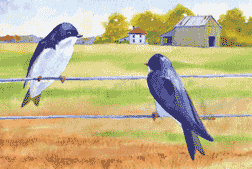 |
Earth Journal by Gary Pendleton |
Tree Swallows Fly in with Spring
Build them a home and they will come
The hirundines are a most inoffensive, harmless, entertaining, social and useful tribe of birds: they touch no fruit in our gardens. Delight, all except one species, in attaching themselves to our houses. Amuse us with their migrations, songs and marvelous agility. And clear our outlets from the annoyances of gnats and other troublesome insects.
–Gilbert White, The Natural History of Selbourne, 1789
The world was in turmoil when those words were published, but the vicar of Selborne was thinking about birds, tortoises, insects, earthworms and all kinds of plants and animals. He believed in nature’s ability to withstand disaster, and he celebrated the efforts of human and animal communities to survive. His message resonates today, when his classic book of nature writing is still in print.
The hirundines he wrote of are swallows; hirundidae is the scientific name for that family of birds. White studied virtually every aspect of natural history in and around his parish in Southern England, but he singled out the swallows, martins and swifts for special attention. No doubt he loved them for their beautiful forms and graceful aerobatics as well as their reputed ability to control annoying insects. White was correct to group the swallow with the martins, but as birders know, swifts are a different kind of bird.
On this side of the Atlantic, we have our own assortment of swallows plus a martin and swifts too. Six kinds of swallows inhabit the eastern U.S.; all are warm-weather residents. Tree swallows are the first of their kind to arrive in the spring, appearing in the Mid-Atlantic in late March or early April.
Many of their numbers overwinter along the south Atlantic and Gulf coasts, which helps explain their status as early arrivers. In the colder months, they subsist on the berries of the wax myrtle, a food that few other birds are able to stomach. The shrub grows abundantly in coastal areas.
Swallows are sleek and aerodynamic; they have long, pointed wings and forked tails.
Tree swallows, Tachycineta bicolor, are as their scientific name implies, two-toned. In adults, the upperparts appear to be almost black but are actually iridescent blue-green; underparts are snowy white. They prefer open areas near water, where they build nests in tree cavities or birdhouses.
If you live near the water, you can put up a birdhouse in hopes of attracting a pair of tree swallows. But you need to hurry to have it occupied this year. Find instructions for a birdhouse for tree swallows at www.coveside.biz/tree-swallow-house-plans.html, or check with your local birding supply store.
Scientific name: Tachycineta bicolor
Where to find tree swallows: Open areas near water, especially where birdhouses are installed
Places to visit: Downs Park or Jefferson Patterson Park
What to look for: Sleek, two-toned birds with pointed wings and forked tails
|


